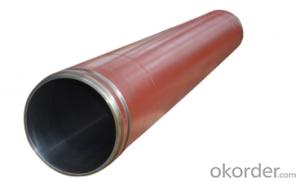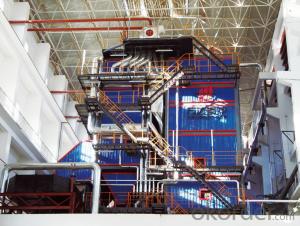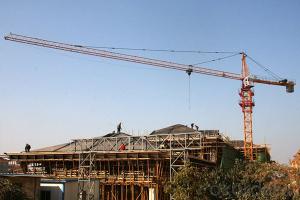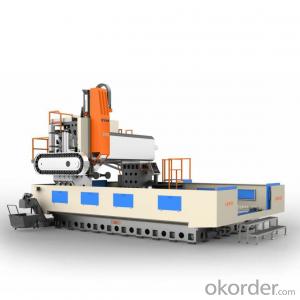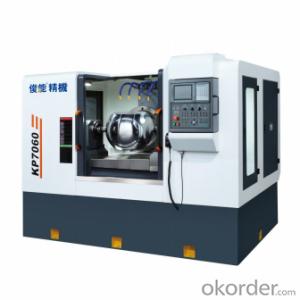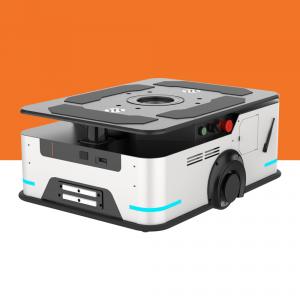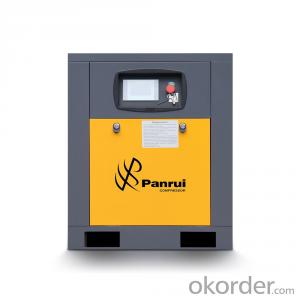DELIVERY CYLINDER(PM ) I.D.:DN230 CR. THICKNESS :0.25MM-0.3MM LENGTH:2320MM
- Loading Port:
- Shanghai
- Payment Terms:
- TT OR LC
- Min Order Qty:
- 2 pc
- Supply Capability:
- 1000 pc/month
OKorder Service Pledge
Quality Product, Order Online Tracking, Timely Delivery
OKorder Financial Service
Credit Rating, Credit Services, Credit Purchasing
You Might Also Like
Packaging & Delivery
| Packaging Detail: | wooden case, seaworthy packing |
| Delivery Detail: | 15 days |
Specifications
Concrete Pump Delivery Cylinder DN230*2100
1. Capacity: 60,000~80,000cbm
2. Size: DN180, DN200, DN230..
4. Brand: PM, Sany,ZM
Concrete Pump Delivery Cylinder DN230*2100
1. Material: C45
2. quenching and tempering to improve the hardness to HB241-280
3. inner wall chrome thickness is 0.25-0.30mm, hardness HV820-900.
4. Brand: SCHWING, PM, SANY, KYOKUTO, CIFA
5. Capacity: 60,000~80,000cbm
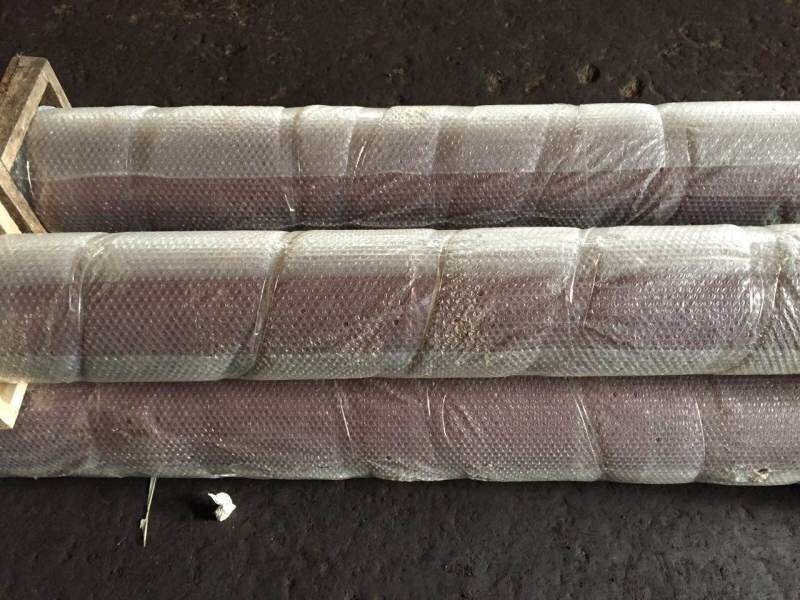
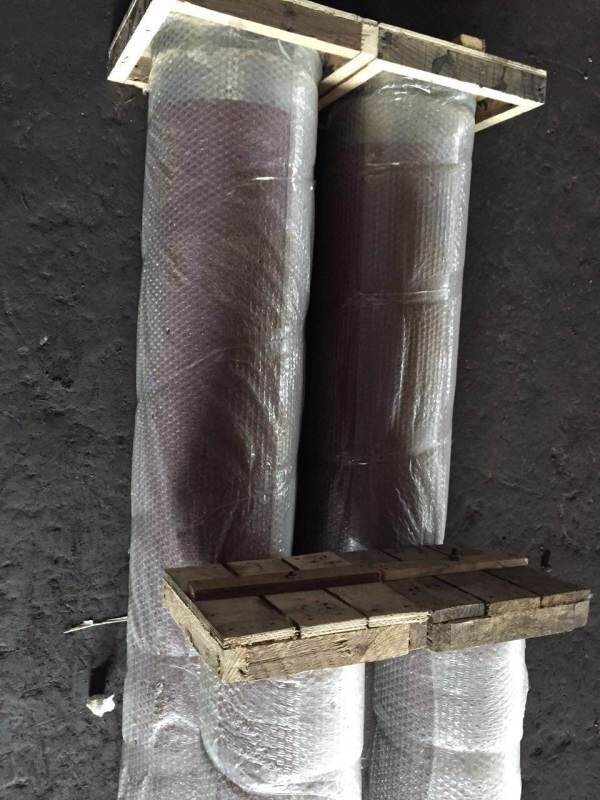
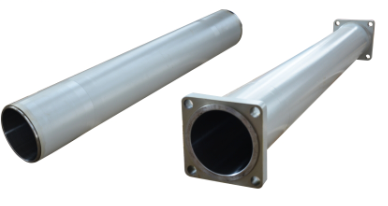
- Q:How often should concrete pump pressure gauges be inspected and replaced?
- Regular inspections of concrete pump pressure gauges are necessary to ensure they are accurate and functioning properly. The frequency of inspections and replacements may vary depending on the specific conditions and usage of the pump. However, it is generally recommended to inspect and replace pressure gauges at least once a year or after every 500 pumping hours, whichever comes first. This regular schedule helps prevent any potential accuracy or functionality issues that could impact the safety and efficiency of the pumping operations. It is also essential to adhere to the manufacturer's recommendations and guidelines for pressure gauge maintenance and replacement to maintain optimal performance and longevity.
- Q:What are the signs of a damaged concrete pump accumulator?
- Some signs of a damaged concrete pump accumulator may include leaks or fluid seepage, reduced pump performance, irregular pressure readings, increased noise or vibration, and sudden pump shutdowns or malfunctions.
- Q:How can a malfunctioning hydraulic motor affect the pumping process?
- Various negative effects can occur in the pumping process due to a hydraulic motor malfunction. Firstly, there may be a decrease in pumping efficiency. The hydraulic motor is responsible for converting hydraulic energy into mechanical energy, which drives the pumping mechanism. If the motor is not functioning properly, it may not generate enough power to operate the pumping system effectively, resulting in a decrease in the volume or pressure of the pumped fluid. Moreover, an increase in energy consumption can be caused by a faulty hydraulic motor. Inefficient or faulty motor operation can lead to higher energy requirements to maintain the desired pumping rate. This increased energy consumption can result in higher operating costs and reduced overall system performance. Furthermore, irregular pumping or complete pump failure can occur as a result of a malfunctioning hydraulic motor. If the motor is not operating correctly, it may cause intermittent or inconsistent pumping, leading to fluctuations in the flow rate or pressure of the pumped fluid. In extreme cases, the motor may stop working entirely, resulting in a total loss of pumping functionality. Additionally, the entire pumping system may experience increased wear and tear due to a malfunctioning hydraulic motor. Improper motor operation can create excessive vibration or heat, leading to premature failure of other components such as seals, bearings, or pistons. This can result in frequent maintenance or repair requirements, leading to increased downtime and costs. In summary, the pumping process can be significantly affected by a malfunctioning hydraulic motor. This includes decreased efficiency, increased energy consumption, irregular pumping or complete pump failure, and increased wear and tear on the system. It is essential to regularly inspect and maintain hydraulic motors to ensure proper functioning and avoid potential issues that may disrupt the pumping process.
- Q:What are the advantages of using OEM (Original Equipment Manufacturer) concrete pump spare parts?
- Using OEM (Original Equipment Manufacturer) concrete pump spare parts offers several benefits: 1. Quality Assurance: OEM spare parts are made by the same company that produces the original equipment, ensuring that they meet the same high-quality standards as the original components. By using OEM parts, the concrete pump will perform optimally with minimal risk of breakdowns or failures. 2. Compatibility: OEM spare parts are specifically designed to fit perfectly with the original equipment. They are built to exact specifications and dimensions, allowing for seamless integration with the concrete pump. This compatibility ensures proper and efficient functioning of the parts. 3. Reliability: OEM spare parts undergo extensive testing by the manufacturer to ensure their reliability and durability. This reduces the likelihood of premature failure or wear, resulting in reduced downtime and maintenance costs. The reliability of OEM parts also minimizes the risk of accidents or injuries caused by faulty equipment. 4. Warranty Coverage: Many OEM spare parts come with a manufacturer warranty, providing protection against defects or failures. This warranty gives customers peace of mind and assurance that they are investing in high-quality components. In case of any issues, the manufacturer typically provides support and assistance. 5. Technical Support: OEM manufacturers usually offer technical support and assistance to customers using their spare parts. This support is invaluable for troubleshooting issues, providing guidance on installation or maintenance, and optimizing the performance of the concrete pump. Non-OEM parts may not offer the same level of support. 6. Long-Term Cost Savings: While OEM spare parts may have a higher upfront cost compared to non-OEM alternatives, they often prove to be more cost-effective in the long run. Their superior quality and reliability result in fewer breakdowns, reduced maintenance expenses, and extended equipment lifespan. Using OEM parts also helps maintain the resale value of the concrete pump. In conclusion, the advantages of using OEM concrete pump spare parts include quality assurance, compatibility, reliability, warranty coverage, technical support, and long-term cost savings. By choosing OEM parts, users can ensure smooth and efficient operation of their concrete pump while minimizing risks and maximizing their investment's return.
- Q:Are there any specific safety precautions while replacing concrete pump spare parts?
- Yes, there are several safety precautions that should be followed while replacing concrete pump spare parts. 1. Personal Protective Equipment (PPE): It is essential to wear the appropriate PPE, including safety goggles, gloves, helmet, and steel-toed boots to protect yourself from potential hazards. 2. Lockout/Tagout: Before replacing any spare parts, make sure to follow proper lockout/tagout procedures. This involves disconnecting and securing the power source to prevent accidental startup of the pump. 3. Equipment Inspection: Prior to starting the replacement process, inspect all tools and equipment for any signs of damage or defects. Faulty equipment should never be used, as it can pose serious safety risks. 4. Proper Lifting Techniques: When handling heavy spare parts, use proper lifting techniques to avoid strain or injury. Ensure that you have proper assistance and equipment, such as cranes or forklifts, if needed. 5. Work Area Safety: Keep the work area clean and well-organized to prevent trips, slips, and falls. Remove any obstacles or debris that may pose a hazard during the replacement process. 6. Proper Training: Only trained and authorized personnel should be involved in replacing concrete pump spare parts. They should have a clear understanding of the equipment and procedures to minimize the risk of accidents. 7. Follow Manufacturer's Instructions: Always refer to the manufacturer's guidelines and instructions when replacing spare parts. This will ensure that the process is carried out safely and correctly. 8. Emergency Preparedness: Have a plan in place for any potential emergencies, such as a fire or injury. Ensure that fire extinguishers and first aid kits are readily available and that all workers are familiar with their locations and usage. By adhering to these safety precautions, you can minimize the risk of accidents, injuries, and damage while replacing concrete pump spare parts.
- Q:Can concrete pump spare parts be recycled or disposed of responsibly?
- Yes, concrete pump spare parts can be recycled or disposed of responsibly. Many of the components used in concrete pump spare parts are made of materials such as steel, iron, and rubber, which can be recycled. These materials can be separated and sent to recycling facilities where they can be processed and reused in the manufacturing of new products. Additionally, responsible disposal methods can also be utilized for concrete pump spare parts that cannot be recycled. This includes ensuring that they are disposed of in designated waste management facilities, where they can be properly treated and managed. By recycling or disposing of concrete pump spare parts responsibly, we can minimize the environmental impact associated with their production and disposal. It is essential to follow proper recycling and waste management practices to ensure a sustainable approach towards the lifecycle of these spare parts.
- Q:What is the role of a concrete pump spectacle plate?
- The role of a concrete pump spectacle plate is to provide support and stability to the concrete pump's boom. It acts as a mounting base for the pipeline, allowing the pump to accurately and efficiently deliver concrete to the desired location.
- Q:Can I get spare parts for both single-cylinder and multi-cylinder concrete pumps?
- Yes, spare parts are available for both single-cylinder and multi-cylinder concrete pumps.
- Q:What is the purpose of a concrete pump remote control battery?
- The purpose of a concrete pump remote control battery is to provide power for the remote control device, allowing operators to remotely control the concrete pump's functions and movements without being physically connected to the machine.
- Q:Are there any specific safety considerations when using concrete pump spare parts?
- Yes, there are specific safety considerations when using concrete pump spare parts. It is essential to ensure that the spare parts are compatible with the concrete pump and installed correctly to prevent any potential hazards. Regular inspections and maintenance of the spare parts are also crucial to ensure their safe and efficient operation. Additionally, following proper safety protocols, such as wearing appropriate personal protective equipment and adhering to manufacturer guidelines, is necessary to minimize the risk of accidents and injuries.
1. Manufacturer Overview |
|
|---|---|
| Location | |
| Year Established | |
| Annual Output Value | |
| Main Markets | |
| Company Certifications | |
2. Manufacturer Certificates |
|
|---|---|
| a) Certification Name | |
| Range | |
| Reference | |
| Validity Period | |
3. Manufacturer Capability |
|
|---|---|
| a)Trade Capacity | |
| Nearest Port | |
| Export Percentage | |
| No.of Employees in Trade Department | |
| Language Spoken: | |
| b)Factory Information | |
| Factory Size: | |
| No. of Production Lines | |
| Contract Manufacturing | |
| Product Price Range | |
Send your message to us
DELIVERY CYLINDER(PM ) I.D.:DN230 CR. THICKNESS :0.25MM-0.3MM LENGTH:2320MM
- Loading Port:
- Shanghai
- Payment Terms:
- TT OR LC
- Min Order Qty:
- 2 pc
- Supply Capability:
- 1000 pc/month
OKorder Service Pledge
Quality Product, Order Online Tracking, Timely Delivery
OKorder Financial Service
Credit Rating, Credit Services, Credit Purchasing
Similar products
New products
Hot products
Related keywords
